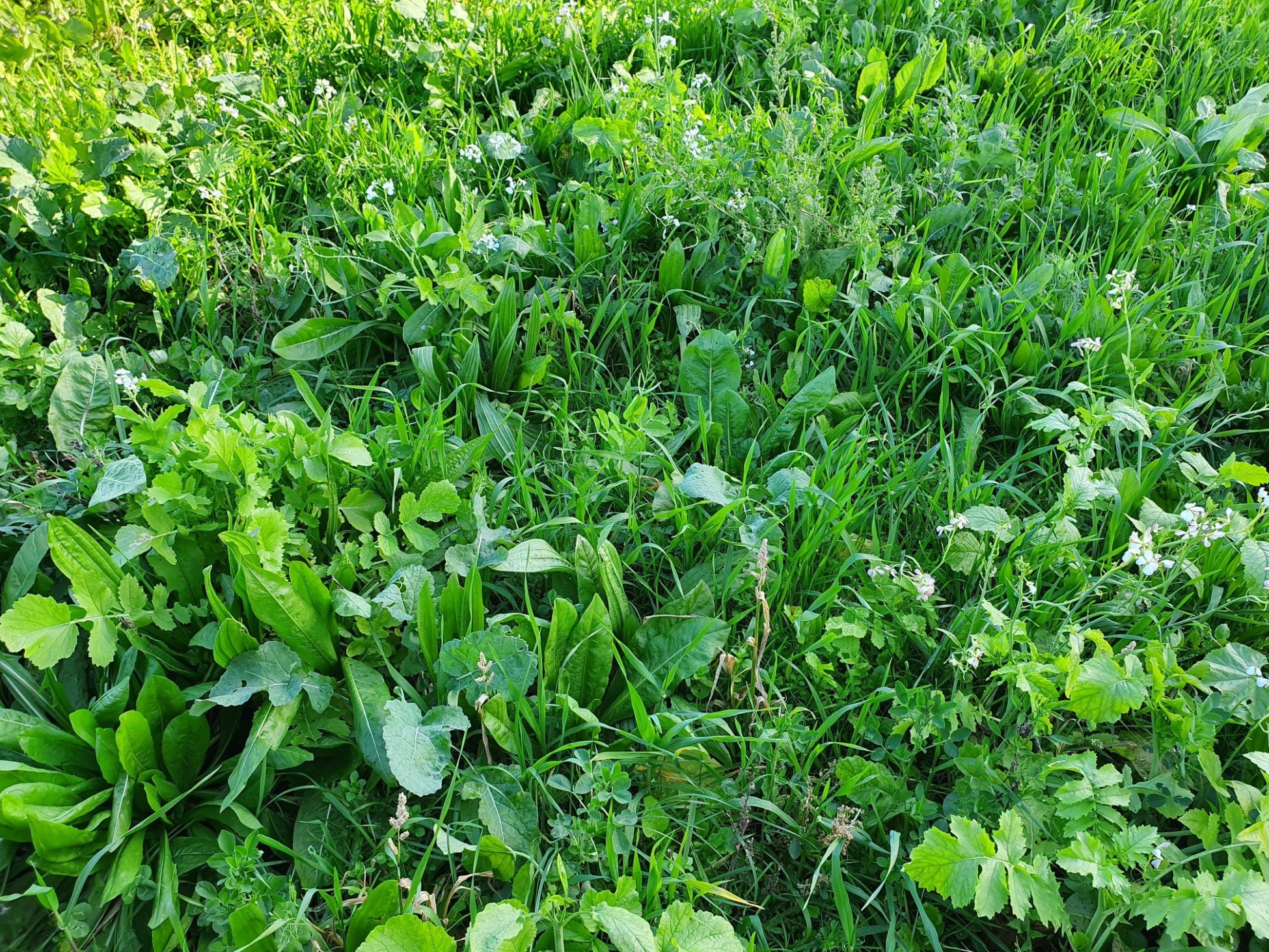
Perennial & Biodiverse Pastures
Public Group
Active a week ago
A group for members interested in pasture species applicable to a high winter rainfall... View more
Red Legged Earth Mite
-
Red Legged Earth Mite
Posted by Will McGirr on 11/06/2024 at 1:12 pmI’m having a severe infestation on my broad leafed plants/seedlings – on radish, clovers & Vetch.
Any non chemical ways of halting this?
Will McGirr replied 1 year, 5 months ago 6 Members · 18 Replies -
18 Replies
-
From Lyudmyla Sharma on Farm-made Biofertz(Facebook)
Adding chitin to seed coating or in furrow feeds and breeds microorganisms capable of assimilating chitin including entomopathogenic fungi that are indigenous to your soils – in affect creating in situ IPMO. Fermented insects crustaceans and other arthropods, fish scales and fungal mycelia are all good sources of chitin.
Entomopathogenic fungi that can help balance insect populations especially in humid climates because the spores of entomopathogenic fungi need moisture to germinate and form the infective structures called conidia. Moisture helps facilitate attachment of the spores to the insect cuticle and penetration of the conidia into by softening the insect’s exoskeleton.
After penetration, the fungus grows inside the insect host, ultimately killing it. Adequate humidity is crucial for fungal growth and sporulation within the insect. After penetration, the fungus grows inside the insect host, ultimately killing it. Adequate humidity is crucial for fungal growth and sporulation within the insect.
While entomopathogenic fungi are more effective in humid conditions, they can still work to some extent in drier environments, especially if there are occasional periods of high humidity or if the insect host provides some moisture. However, their efficacy is generally reduced in dry conditions.
Several entomopathogenic fungi are similar to Beauveria bassiana, in their ability to infect and kill insects. These fungi are often used in biological pest control and have similar modes of action:
-
Metarhizium anisopliae: Metarhizium species are commonly used in insect biocontrol. They infect a wide range of insects, including beetles, grasshoppers, and certain agricultural pests.
-
Cordyceps spp.: Cordyceps is a genus of entomopathogenic fungi known for their parasitic lifestyle. They infect various insects, such as ants, caterpillars, and other arthropods, and are famous for their ability to manipulate the behavior of their hosts.
-
Isaria fumosorosea (formerly Paecilomyces fumosoroseus): Isaria fumosorosea is effective against aphids, whiteflies, thrips, and other plant pests. It’s commercially available as a biopesticide.
-
Nomuraea rileyi: This fungus primarily targets lepidopteran pests, including caterpillars and moth larvae. It’s used to control insects like corn earworms and armyworms.
-
Hirsutella spp.: Various species of Hirsutella are entomopathogenic and infect a wide range of insects, including aphids, mites, and scale insects.
-
Entomophthora spp.: Entomophthora fungi are parasitic on a variety of insects, such as flies, aphids, and grasshoppers. They cause the host to climb to a high point before releasing spores, aiding in the spread of the fungus.
These entomopathogenic fungi have different host ranges and specificities, so their effectiveness may vary depending on the target insect pest. When considering biological control using these fungi, it’s essential to select the most appropriate species or strain based on the specific pest problem you are addressing.
In areas with consistently low humidity, alternative DIY IPMOs or Integrated pest management methods that include bird, reptile, amphibian, and bat habitats as well as areas where entomopathogenic fungi can help maintain balance and curb overpopulation of pest insects even in dry conditions.
https://www.youtube.com/watch?v=w9R_Q3MLvC0 -
-
I haven’t tried this but apparently a mix of milk and molasses diluted in water and sprayed out over the area might do the trick.
-
Hi Will, We have had some red legs in some of the paddocks we seeded to multi species.. in particular they were hammering the legumes & brassicas. Mark Tupman @mark suggested spraying out Magnesium Suplhate at a rate of 5 to 7kg/ha along with some molasses… our soils are quite deficient in magnesium & I think if my understanding is correct, magnesium is essential for protein synthesis (converting nitrate to ammonia to proteins) & molasses helps to provide energy for the process, and RELM love high nitrate conditions.. but I’ll leave Mark to explain further &/or correct me.
-
I’ve also got a battle on my hands! I’m going to try and foliar spray one of Mark’s recipes hopefully next week and see if it slows the buggers down. Brett do you know the amounts used for molasses/milk spray?
Photo is of last years multi species(which was also attacked badly), I’m guessing there was a huge egg population laid last spring as I left it standing to seed and hence the explosion. Would be great to hear from those who have overcome them and give us all some hope that we can do it 😅
If anyone tries a foliar or molasses etc would be great to hear their results, even if it was over a couple of seasons.
-
At a guess I would go say 5 litres/ ha of each
It was in a John Kempf book that I don’t have on me currently
-
-
Hello All
Touch wood I’ve had no red legs (yet!!)
About 3-4 weeks after seeding (30 April) I put out the following mix
Per 500 litre tank load = covers 2-3ha with the Tow and Fert
Fish Hydrolysate 35 litres (brewed on farm)
JS mix 8kg (made on farm and ~8 months old)
Seaweed solid extract 850g (Soil Dynamics)
Fulvic Acid Powder 1.5kg (Soil Dynamics)
Potassium Humate Powder 1.5kg (Soil Dynamics)
Molasses 10kg (half a container)
trace elements 1kg (Campbells Trace-It Total)
MPK 3kg (Campbells Solu-MKP)
Eco-flo lime 750ml (micronized liquid lime)
Magnesium 1kg (Campbells Solu-Mag)
Potassium 1kg (Campbells Solu-K)
The tow and fert pic shows the grow stage when I sprayed to get both the soil and new growth (22 May)
Attached are some photos from last week (3 June) of the paddocks which now have our ewes in for lambing due to commence next week. The ruler is 15cm as a reference.
I should add our hill looks about half as good due to it being more sandy – so I’ve shown you the good areas 🙂
As a reference last year I only sprayed out a worm juice with molasses and seaweed about 3-4 weeks after seeding and only had a couple of spots of red legs appear (only a few square meters here and there)
-
This is the Tow and Fert spraying out at Kate and Lloyds farm. Gets about a 8-10m width.
-
Brett will you foliar go out through a normal boom spray doing 100l/ha? I’m thinking maybe not the lime product but the rest?
-
Everything should dissolve with the exception of the JS mix. So it can go out through the the boom spray but you see a lot of people put it through a 100 micron filter from a dissolving tank.
part of the reason I bought the T&F as it uses a trash pump, that helps mix and dissolve with no filters and a 3mm spray orifice. Removes the majority of blockage problems
-
-
-
Looks like getting those foliars out earlier gave the plants a good head start & stave off RELM, I got some out on a couple of paddocks at the same time as you and no sign of them whereas the other paddocks all have some to varying degrees, only got foliars on them last week – plants looking like they are going to grow through the damage though so hope that’s the case.
-
-
Thanks Brett for the detailed info. Great to hear you’re having success against them with the limited foliars. Good news 👍
-
Hi Will,
Yes, the RLEM is definitely making its presence felt around the place atm.
There is definitely something about healthy plants or plants growing in healthy soil that seems to impart red legged resistance as we commonly see healthy plants untouched while others in not such a good paddock are getting hammered.
The exact reason for this is still unclear but it is understood that plants with poor photosynthesis/low brix and poor nitrate/ammonium to protien conversion are more susceptible to attack from sap sucking insects.
There are certain nutrients needed for both these processes to work efficiently I.e. magnesium, iron, manganese, sulphur, molybdenum…
We can hedge our bets by applying a foliar spray of the nutrients needed along with fulvic acid to improve uptake, molasses for energy etc…
The recipe that Kate attached fits the bill but make sure to include the following optional extras from the list – molasses, magnesium sulphate, fish hydrolysate and sodium molybdate.
An application of this sort can be very beneficial and may help you overcome the RLEM problem.
-
Hi Mark,
thanks for the reply and input. After emergence last year I sprayed on your suggested mix – does it need to be put on every year? I didn’t put it on yet this year.
-
Unless the soil is in a healthy and fertile enough state to support the plants adequately 😏
-
-
-
Log in to reply.

